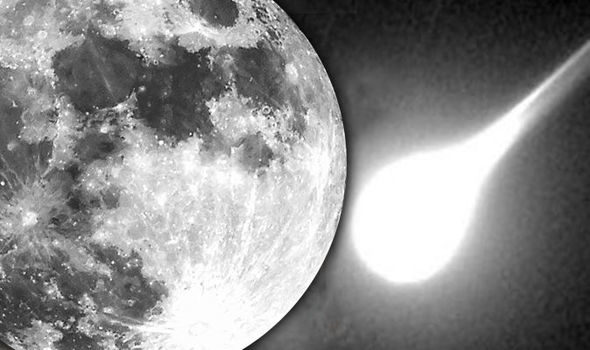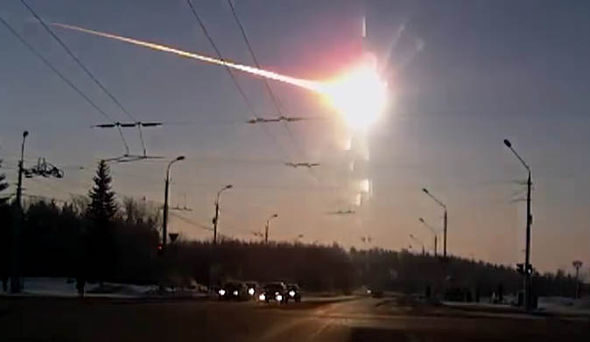
© GettyThe moon was struck by a meteor creating an explosion visible with the naked eye.
A METEOR with the explosive power of TEN cruise missiles has struck the Moon - sparking a massive explosion visible with the naked eye.
And terrifyingly the 56,000 mph collision - captured by NASA scientists highlighting the catastrophic danger planet earth faces from similar meteors - was caused by a space rock
weighing no more than 88 lbs (40 kilos).
Despite the meteor's tiny proportions - about the size of a small boulder and the weight of an average 10-year-old boy - the impact damage was colossal and the explosion shone with the brightness of a magnitude 4 star.
A similar strike against a city on earth would create a crater 65feet (20m) deep and create a devastating kill zone equivalent to TEN Tomahawk cruise missile striking in exactly the same place.
Experts fear the death toll would run into thousands.
Unlike the Moon the Earth has a protective atmosphere meaning most space debris burns up before it can impact.
But bigger meteors sometimes get through - most recently at Chelyabinsk in Russia where a 20 metre asteroid travelling at 43,000 mph breached the atmosphere and exploded with the power of 33 Hiroshimas.
Fortunately because of the speed and angle of entry the rock exploded while still in the air but 7,200 buildings were damaged and 1,500 people were injured seriously enough to seek medical treatment.
A spokesman for respected science website Science.com said: "For the past eight years NASA has been monitoring the Moon for signs of explosions caused by meteors.
"They've just seen the biggest explosion in the history of the programme.
"It exploded in a flash 10 times as bright as anything we've seen before. Anyone looking at the Moon at the moment of impact could have seen the explosion - no telescope required."
The Chelyabinsk meteor is the largest known natural object to have entered Earth's atmosphere since the 1908 Tunguska meteor, which destroyed a wide, remote, forested, and very sparsely populated area of Siberia.
NASA is so concerned about the possibility of an asteroid strike ending all life on earth it has started the first design phase of a spacecraft known as the Double Asteroid Redirection Test (DART) which will be used to redirect an asteroid's path.
NASA is working in conjunction with the European Space Agency (ESA) on the craft and hope to have the first space tests underway by 2022 where it will attempt to move a "non-threatening" asteroid.

© GettyExperts fear a similar impact on earth could cause tens of thousands of deaths.
Lindley Johnson, planetary defence officer at Nasa Headquarters in Washington, said: "DART would be NASA's first mission to demonstrate what's known as the kinetic impactor technique - striking the asteroid to shift its orbit - to defend against a potential future asteroid impact.
"This approval step advances the project toward an historic test with a non-threatening small asteroid."


Reader Comments
Folks, it's scientism fear porn. Stop being in love with being afraid and traumatized.
When, exactly, did this happen?
Meteors hit planets!
BUT
The atmosphere here burns them up, mostly
BUT
You are in severe danger
BUT
NASA will save you
But
They need money
BUT
It could save Earth
BUT
Going to get YOU SOON!!
WOW nice neat number that meteor weight, matches the old but feared German 88mm. 56k MPH...Not 55 but 56.
Damn they are good
1). How could a "hit" by this 88 lb. rock be seen by the naked eye in an atmosphere with no friction,
And
2). from 240,000 miles away? Logically, do you believe had you been on top of the Himalayas you may have videod "Shock and Awe" in Bagdad, only a few thousand miles away? Do you believe from the highest Rockie Mountain peak that you can see sun reflecting off a Volkswagen windsheild 2 states away?
Well, no, because of the earth's curvature, you say. Nope. Do the math. The mountain height should give you over sight. Well, no, because of the atmosphere, you say. Nope. That same atmosphere should distort moon viewing.
3). Repeatable experiements prove that without oxygen, fire cannot burn, and so...no fiery meteor bombs in a vacumn.
4). If we're so concerned about this phenomenon, why do we not have uninterrupted live-stream pictures of all moon possible events? We're told we'd be bombarded by hundreds of meteors a day, were it not for our atmosphere, which burns them up. So....with no atmosphere, the moon should be HIT hundreds of times a day. Pyrotechnics should be at least a couple of times a week.
Isnt this the plot to the movie asteroid?
They send the space shuttle out to intercept a giant space rock, place nukes on, and then blow it up in an attempt to redirect it...
I guess some nasa beurocrates saw that and thought: "this is a plausible excuse to demand more money!"